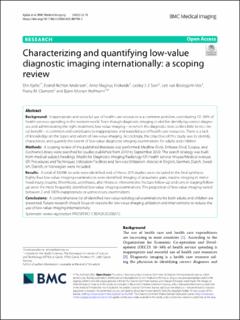| dc.description.abstract | Background
Inappropriate and wasteful use of health care resources is a common problem, constituting 10–34% of health services spending in the western world. Even though diagnostic imaging is vital for identifying correct diagnoses and administrating the right treatment, low-value imaging—in which the diagnostic test confers little to no clinical benefit—is common and contributes to inappropriate and wasteful use of health care resources. There is a lack of knowledge on the types and extent of low-value imaging. Accordingly, the objective of this study was to identify, characterize, and quantify the extent of low-value diagnostic imaging examinations for adults and children.
Methods
A scoping review of the published literature was performed. Medline-Ovid, Embase-Ovid, Scopus, and Cochrane Library were searched for studies published from 2010 to September 2020. The search strategy was built from medical subject headings (Mesh) for Diagnostic imaging/Radiology OR Health service misuse/Medical overuse OR Procedures and Techniques Utilization/Facilities and Services Utilization. Articles in English, German, Dutch, Swedish, Danish, or Norwegian were included.
Results
A total of 39,986 records were identified and, of these, 370 studies were included in the final synthesis. Eighty-four low-value imaging examinations were identified. Imaging of atraumatic pain, routine imaging in minor head injury, trauma, thrombosis, urolithiasis, after thoracic interventions, fracture follow-up and cancer staging/follow-up were the most frequently identified low-value imaging examinations. The proportion of low-value imaging varied between 2 and 100% inappropriate or unnecessary examinations.
Conclusions
A comprehensive list of identified low-value radiological examinations for both adults and children are presented. Future research should focus on reasons for low-value imaging utilization and interventions to reduce the use of low-value imaging internationally. | en_US |

